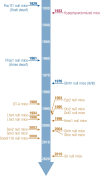Common and Uncommon Mouse Models of Growth Hormone Deficiency
- PMID: 38853618
- PMCID: PMC12102728
- DOI: 10.1210/endrev/bnae017
Common and Uncommon Mouse Models of Growth Hormone Deficiency
Abstract
Mouse models of growth hormone deficiency (GHD) have provided important tools for uncovering the various actions of GH. Nearly 100 years of research using these mouse lines has greatly enhanced our knowledge of the GH/IGF-1 axis. Some of the shared phenotypes of the 5 "common" mouse models of GHD include reduced body size, delayed sexual maturation, decreased fertility, reduced muscle mass, increased adiposity, and enhanced insulin sensitivity. Since these common mouse lines outlive their normal-sized littermates-and have protection from age-associated disease-they have become important fixtures in the aging field. On the other hand, the 12 "uncommon" mouse models of GHD described herein have tremendously divergent health outcomes ranging from beneficial aging phenotypes (similar to those described for the common models) to extremely detrimental features (such as improper development of the central nervous system, numerous sensory organ defects, and embryonic lethality). Moreover, advancements in next-generation sequencing technologies have led to the identification of an expanding array of genes that are recognized as causative agents to numerous rare syndromes with concomitant GHD. Accordingly, this review provides researchers with a comprehensive up-to-date collection of the common and uncommon mouse models of GHD that have been used to study various aspects of physiology and metabolism associated with multiple forms of GHD. For each mouse line presented, the closest comparable human syndromes are discussed providing important parallels to the clinic.
Keywords: combined pituitary hormone deficiency; growth hormone deficiency; isolated growth hormone deficiency; knockout mice; mouse model.
© The Author(s) 2024. Published by Oxford University Press on behalf of the Endocrine Society. All rights reserved. For commercial re-use, please contact reprints@oup.com for reprints and translation rights for reprints. All other permissions can be obtained through our RightsLink service via the Permissions link on the article page on our site—for further information please contact journals.permissions@oup.com. See the journal About page for additional terms.
Figures



Similar articles
-
Mouse models of growth hormone deficiency.Rev Endocr Metab Disord. 2021 Mar;22(1):3-16. doi: 10.1007/s11154-020-09601-5. Epub 2020 Oct 9. Rev Endocr Metab Disord. 2021. PMID: 33033978 Review.
-
Models of GH deficiency in animal studies.Best Pract Res Clin Endocrinol Metab. 2016 Dec;30(6):693-704. doi: 10.1016/j.beem.2016.11.001. Epub 2016 Nov 4. Best Pract Res Clin Endocrinol Metab. 2016. PMID: 27974185 Review.
-
AMERICAN ASSOCIATION OF CLINICAL ENDOCRINOLOGISTS AND AMERICAN COLLEGE OF ENDOCRINOLOGY GUIDELINES FOR MANAGEMENT OF GROWTH HORMONE DEFICIENCY IN ADULTS AND PATIENTS TRANSITIONING FROM PEDIATRIC TO ADULT CARE.Endocr Pract. 2019 Nov;25(11):1191-1232. doi: 10.4158/GL-2019-0405. Endocr Pract. 2019. PMID: 31760824
-
Adult-onset growth hormone and insulin-like growth factor I deficiency reduces neoplastic disease, modifies age-related pathology, and increases life span.Endocrinology. 2005 Jul;146(7):2920-32. doi: 10.1210/en.2005-0058. Epub 2005 Mar 24. Endocrinology. 2005. PMID: 15790724
-
Isolated growth hormone deficiency in children with vertically transmitted short stature: What do the genes tell us?Front Endocrinol (Lausanne). 2023 Jan 13;13:1102968. doi: 10.3389/fendo.2022.1102968. eCollection 2022. Front Endocrinol (Lausanne). 2023. PMID: 36714562 Free PMC article.
Cited by
-
Biomarkers of GH deficiency identified in untreated and GH-treated Pit-1 mutant mice.Front Endocrinol (Lausanne). 2025 Apr 30;16:1539797. doi: 10.3389/fendo.2025.1539797. eCollection 2025. Front Endocrinol (Lausanne). 2025. PMID: 40370773 Free PMC article.
-
Hypothalamic GHRH.Rev Endocr Metab Disord. 2025 Jun;26(3):297-303. doi: 10.1007/s11154-025-09951-y. Epub 2025 Feb 6. Rev Endocr Metab Disord. 2025. PMID: 39913072 Free PMC article. Review.
-
The impact of inactivation of the GH/IGF axis during aging on healthspan.Geroscience. 2025 Jun;47(3):3027-3042. doi: 10.1007/s11357-024-01426-3. Epub 2024 Nov 13. Geroscience. 2025. PMID: 39535693 Free PMC article.
References
-
- Buchman M, Bell S, Kopchick JJ. Growth hormone discovery and structure. Pediatr Endocrinol Rev. 2018;16(Suppl 1):2‐10. - PubMed
-
- Tatsumi K, Miyai K, Notomi T, et al. Cretinism with combined hormone deficiency caused by a mutation in the PIT1 gene. Nat Genet. 1992;1(1):56‐58. - PubMed
-
- Radovick S, Nations M, Du Y, Berg LA, Weintraub BD, Wondisford FE. A mutation in the POU-homeodomain of Pit-1 responsible for combined pituitary hormone deficiency. Science. 1992;257(5073):1115‐1118. - PubMed
-
- Okamoto N, Wada Y, Ida S, et al. Monoallelic expression of normal mRNA in the PIT1 mutation heterozygotes with normal phenotype and biallelic expression in the abnormal phenotype. Hum Mol Genet. 1994;3(9):1565‐1568. - PubMed
Publication types
MeSH terms
Substances
Grants and funding
LinkOut - more resources
Full Text Sources

